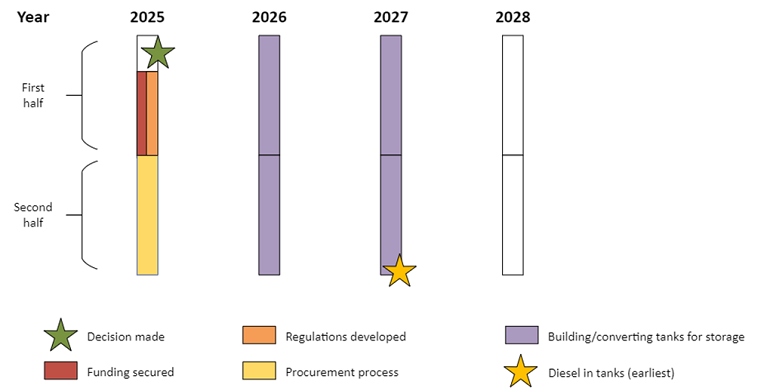Option 3: Government procurement of 70 million litres of diesel (equal to 28 days’ cover)
This option would involve the government entering into a long-term lease agreement for new diesel storage capacity and procuring up to 70 million litres of onshore reserve diesel stocks.
On this page
We anticipate that, similar to the former ‘reserve diesel arrangement’, the government would seek requests for proposals for storage before procuring diesel. This could allow the government to take a strategic view of where diesel reserves are sited, potentially enhancing our domestic resilience.
We are considering whether it is appropriate for the Levy to fund the initial procurement of diesel as well as operational costs, or whether we rely on funding from general taxation for the procurement of diesel with the Levy funding ongoing operational costs. The latter was what was envisaged as part of the reserve diesel arrangement.
We had previously discounted using the Levy to fund the entirety of an increased diesel reserve as the Auditor-General’s best practice guidance on setting fees and levies states that it is generally not appropriate to include capital expenditure, ie purchasing diesel, when calculating a levy. Recovering capital costs in the year they were incurred can treat current and future levy payers inequitably because one group would pay for something they may not get the benefit of.
On further consideration, equity issues are unlikely to be a significant concern given the very large number of levy payers (ie all fuel consumers). We also consider that the benefit the extra resilience could bring to all fuel consumers, potentially justifying a deviation from the Auditor-General’s guidance.
Impacts on competition
This option would minimise the market distortions that would otherwise result from requiring fuel importers to hold more stocks in addition to the MSO requirements.
Cost impact
Crown procurement is likely to have the least cost impacts to consumers at the pump. Fuel companies require a higher rate of returns on investments and face a higher cost of capital than Government, as they need to deliver profits for their shareholders to remain viable.
This option also gives the Government the most certainty and control over the costs being passed down to consumers.
Based on preliminary numbers from stakeholders, we estimate that storage lease (excluding turnover costs), could cost the Crown between $150,000 to $250,000 per million litres of diesel annually, over 15 years.
If we were to use Levy funding to fund the procurement of reserve diesel as well as operational costs, the Levy rate would likely need to increase, as set out below.
Initially, the Levy rate would need to increase an estimated 0.4 to 0.5 cents per litre for the first 3 years. This would cover the cost of diesel procurement and storage lease costs (including both capital and operational expenditure). The increase would drop down to around 0.25 cents per litre thereafter to cover ongoing storage lease costs, stock turnover and other management costs.
Table: Levy rate increase over time
| Year | 2025/26 | 2026/27 | 2027/28 | 2028/29 and onwards |
|---|---|---|---|---|
| Levy rate increase (cents per litre) | 0.4 - 0.5 | 0.25 | ||
These numbers reflect our current estimates. The exact cost (and therefore Levy impact) would depend on the costs of tank storage and stock management, fluctuation of diesel costs, and any smoothing of the Levy rate increase. We have assumed that we can build up a surplus in the Levy over 3 years so we could procure the diesel while minimising impacts to consumers.
An increase in onshore stockholding would mean New Zealand would not need to purchase so many IEA oil tickets. It is possible the Levy rate increase could be lower but we have not factored this in.
If we were to rely on general taxation, most of the costs of diesel procurement would fall on taxpayers, as opposed to fully using the Levy, which would impose the cost on fuel consumers only. We consider this could also be appropriate as all New Zealanders will benefit from improved diesel resilience in the case of a supply shortage/emergency. In addition, this option is likely to be fiscally neutral over time. As diesel is a non-depreciating asset, the initial cost of diesel procurement could be recovered when the diesel is sold.
Consultation question 12
12. Do you have a preference about whether the government uses Levy funding or general taxation if option 3 was adopted?
Administrative efficiency and timing
This option is likely to take longer than simply increasing the MSO for diesel as it would require the government to progress another procurement process. We would expect diesel in tanks by 2027 to 2028.
Beyond the procurement of storage and stock, the Crown would have to manage ongoing storage and stock management contracts. The government holding such a large asset comes with its own risks.
Figure 2: Indicative timelines for Option 3

Read diagram description – Figure 2: Indicative timelines for Option 3
Diesel tanks could be available from 2027 if a decision were made in early 2025, assuming that existing tanks would take 2 years to be converted to diesel and government secures funding for the procurement contracts.
Consultation question 13
13. Given the government has already investigated procuring storage, are our timeframes realistic? What could we do to speed it up?

